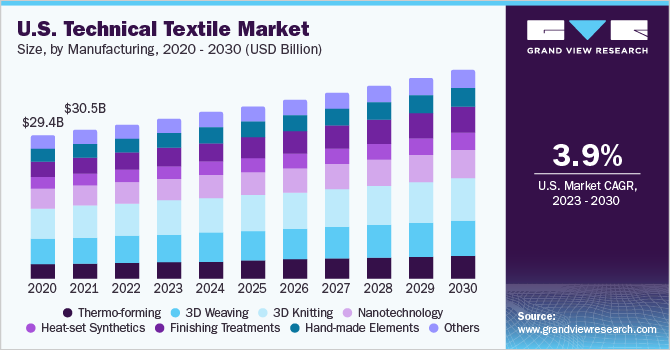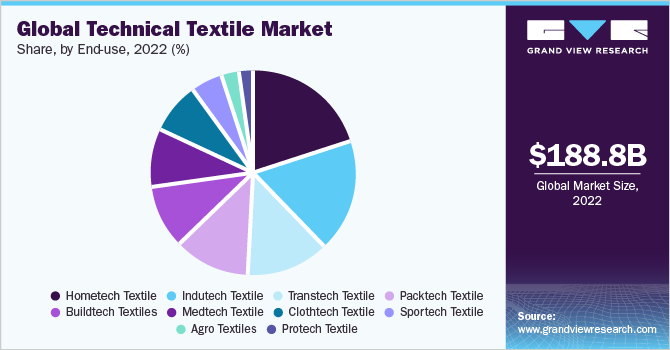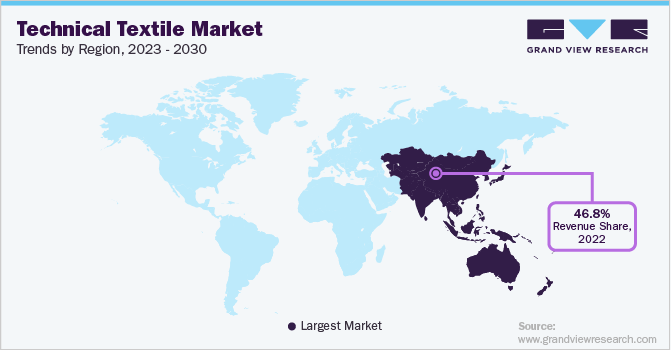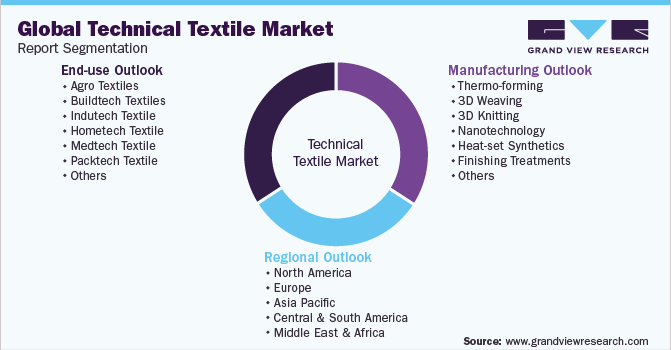- Home
- »
- Advanced Interior Materials
- »
-
Technical Textile Market Size, Share & Growth Report, 2030GVR Report cover
![Technical Textile Market Size, Share & Trends Report]()
Technical Textile Market Size, Share & Trends Analysis Report By Manufacturing (3D Weaving, Thermo-forming, 3D Knitting), By End-use (Agro Textiles, Hometech Textiles), By Region, And Segment Forecasts, 2023 - 2030
- Report ID: 978-1-68038-154-2
- Number of Report Pages: 158
- Format: PDF, Horizon Databook
- Historical Range: 2018 - 2022
- Forecast Period: 2023 - 2030
- Industry: Advanced Materials
Technical Textile Market Size & Trends
The global technical textiles market size was valued at USD 188.81 billion in 2022 and is expected to grow at a compound annual growth rate (CAGR) of 4.7% from 2023 to 2030. Increasing awareness regarding the benefits of technical textiles in various end-user industries is expected to drive the market over the forecast period.The global industry has experienced moderate growth as a consequence of the economic recession caused by the COVID-19 crisis. During the initial phase, the industrial activities observed setbacks, as a result, the market has also experienced a catastrophic setback. The demand for technical textiles in the U.S. is likely to grow owing to the rising demand for lightweight materials in automotive manufacturing.

These products are found to be 15% to 30% lighter than the traditional materials, which results in reduced weight and increased fuel efficiency of vehicles. In addition, the U.S. is expected to be the largest market in North America, on account of the expansion of industries including medical, agriculture, and construction.Technical textiles majorly use man-made raw materials, such as fibers consisting of viscose, nylon, acrylic/modacrylic, and polymers, which cater to cost-intensive manufacturing techniques. Thus, the technology used for the production of the above-mentioned synthetic raw materials is likely to negatively impact the market growth.
Increasing consumer preference for protective clothing coupled with popular fashion trends is forcing major companies to focus on restructuring their business in terms of adopting new engineering technologies, such as smart textiles and nanotechnology. This, in turn, is expected to increase the overall product cost, thereby acting as a restraint for market growth. A majority of the industry players are focusing on efficient and effective distribution channels by setting up new production plants and establishing partnerships & agreements with several e-commerce portals to ensure a robust supply of products. However, the market has witnessed sluggish growth in the year 2020 due to COVID-19, which is expected to result in slow growth for the first few years over the forecasted period.
Manufacturing Insights
The 3D weaving manufacturing technology segment led the market and accounted for more than 23.45% share of the global revenue in 2022. The demand for 3D weaving technology-based products in the construction, ballistic, automotive, marine, and other application industries drives segment growth. It is expected to retain its dominance throughout the forecast period.3D knitting manufacturing technology finds application in 3D-shaped dimensionality, which is found in knit structures and weft knitting. Moreover, the increasing application of 3D knitting in the construction and civil engineering segment is expected to propel market growth.
Thermoforming manufacturing technology was estimated to account for USD 24.02 billion in 2022. This is attributed to the increasing application of the same in automotive, aerospace & aviation, business machines & equipment, and others. In addition, it is highly used in the medical and healthcare sectors for packaging blisters and other medical equipment.Several other technologies, such as nanotechnology, finishing treatments, and heat-set synthesis, are used in the market to improve the overall appearance, size, and strength of the product. Moreover, increasing the use of nanotechnology in product manufacturing further improves product properties, such as texture, durability, and color.
End-use Insights
The hometech textiles led the industry and accounted for over 19.50% of the global revenue share in 2022. The high share is mainlydue to the increasedproduct demand from the household sector, which includes cushioning materials, furniture, floor & wall covering, fireproofing, and others. This is expected to witness a positive trend in the upcoming periodwith a rise in residential construction, especially in emerging economies. The demand for indutech textiles is anticipated to grow at a significant rate over the forecast period owing to the superior properties, such as durability and strength, for industrial applications.

The rising demand for decatising cloth, bolting cloth, drive belts, printed circuit boards, and others in various application industries is expected to increase the demand for industrial textiles during the forecast period. The increasing population in emerging economies coupled with the rising birth rates and aging population is expected to drive the demand for hygienic and personal care medical equipment over the forecast period.
This is expected to add positive growth to the medtech textile market, thereby adding significant growth to the overall industry. The other end-use segments include agro, buidtech, packatech, and sportech textiles among others. The increasing adoption of advanced technology in agriculture for high crop yield coupled with the rising constructional activities for the residential & commercial segments is expected to boostthe growth of the agro and buildtech textiles end-use segments respectively.
Regional Insights
Asia Pacific dominated the industry and accounted for more than 46.80% share of global revenue in 2022. The region is expected to dominate the market over the forecast period. A rise in demand for apparel & functional, industrial, and protective clothing is expected to boost market growth over the forecast period. The growth of the residential, commercial, and industrial sectors in China coupled with favorable government policies to support the overall textile market in India is expected to add growth prospects to the regional market. Direct involvement of India’s prime minister with the Cabinet Committee on Economic Affairs (CCEA) has targeted to increase the domestic market size to USD 40 to 50 billion by the year 2024.

The product demand in Europe is led by fashion clothing and household applications and the trend is projected to continue over the forecast period. In addition, growth in the tourism & automotive sectors and a rise in healthcare activities are expected to add significant growth to various end-use textile segments, thereby fueling the industry growth. North America is expected to grow at a significant CAGR over the forecast period due to the high demand for products from the construction and healthcare application industries. A rise in infrastructural development and renovation activities is further expected to fuel market growth over the forecast period.
Key Companies & Market Share Insights
The market is making rapid advancements in technical textiles owing to the rapidly changing consumer preference and fluctuating fashion trends. In addition, several players are focusing on thedevelopment of consumer and commercial textiles making them suitable for use in an extensive range of industrial applications. The market is competitive due to the presence of major companies involved in product manufacture.
Key industry players have benchmarked their products on the basis of geographical presence, distribution network, product portfolio, operational capabilities, and innovation. These manufacturers generally enter into long-term contracts with technical fabric providers to avoid fluctuations in raw material prices and disruptions in raw material supply. Some of the prominent players in the global technical textile market include:
-
Low & Bonar PLC
-
Freudenberg Group
-
Berry Global Group, Inc.
-
Ahlstrom-Munksjo
-
Asahi Kasei Advance Corp.
-
Kimberly-Clark Corp.
-
Mitsui Chemicals, Inc.
-
Huntsman International LLC
-
Berry Global Group, Inc.
-
Toray Industries, Inc.
Technical Textile Market Report Scope
Report Attribute
Details
Market size value in 2023
USD 197.22 billion
Revenue forecast in 2030
USD 272.33 billion
Growth rate
CAGR of 4.7% from 2023 to 2030
Base year for estimation
2022
Historical data
2018 - 2022
Forecast period
2023 - 2030
Quantitative units
Volume in kilotons, revenue in USD million/billion, and CAGR from 2023 to 2030
Report coverage
Volume forecast, revenue forecast, company ranking, competitive landscape, growth factors, and trends
Segments covered
Manufacturing, end-use, region
Regional scope
North America; Europe; Asia Pacific; Central & South America; Middle East & Africa
Country scope
U.S.; Canada; Mexico; Germany; U.K.; France; Italy; Spain; Greece; China; India; Japan; Brazil
Key companies profiled
Low & Bonar PLC; Freudenberg Grou; Berry Global Group, Inc.; Ahlstrom-Munksjo; Asahi Kasei Advance Corp.; Kimberly-Clark Corp.; Mitsui Chemicals, Inc; Huntsman International LLC
Customization scope
Free report customization (equivalent up to 8 analysts working days) with purchase. Addition or alteration to country, regional & segment scope
Pricing and purchase options
Avail customized purchase options to meet your exact research needs. Explore purchase options
Global Technical Textile Market Report Segmentation
This report forecasts revenue growth at global, regional, and country levels and provides an analysis of the latest industry trends in each of the sub-segments from 2018 to 2030. For the purpose of this study, Grand View Research has segmented the global technical textile market report on the basis of manufacturing, end-use, and region:

-
Manufacturing Outlook (Volume, Kilotons; Revenue, USD Million, 2018 - 2030)
-
Thermo-forming
-
3D Weaving
-
3D Knitting
-
Nanotechnology
-
Heat-set Synthetics
-
Finishing Treatments
-
Hand-made Elements
-
Others
-
-
End-use Outlook (Volume, Kilotons; Revenue, USD Million, 2018 - 2030)
-
Agro Textiles
-
Buildtech Textiles
-
Indutech Textile
-
Hometech Textile
-
Medtech Textile
-
Packtech Textile
-
Protech Textile
-
Transtech Textile
-
Sportech Textile
-
Clothtech Textile
-
Others
-
-
Regional Outlook (Volume, Kilotons; Revenue, USD Million, 2018 - 2030)
-
North America
-
U.S.
-
Canada
-
Mexico
-
-
Europe
-
Germany
-
U.K.
-
France
-
Italy
-
Spain
-
Greece
-
-
Asia Pacific
-
China
-
India
-
Japan
-
-
Central & South America
-
Brazil
-
-
Middle East & Africa
-
Frequently Asked Questions About This Report
b. The global technical textile market size was estimated at USD 188.81 billion in 2022 and is expected to reach USD 197.22 billion in 2023.
b. The technical textile market is expected to grow at a compound annual growth rate of 4.7% from 2023 to 2030 to reach USD 272.33 billion by 2030.
b. 3D Weaving dominated the technical textile market with a revenue share of 23.6% in 2022, owing to its wide on automotive, aerospace, military, medical & healthcare application industries.
b. Some of the key players operating in the technical textile market include Low & Bonar PLC, Freudenberg Group, Berry Global Group, Inc., Ahlstrom-Munksjo, Asahi Kasei Advance Corporation, Kimberly-Clark Corporation, Mitsui Chemicals, Inc., Huntsman International LLC, among others
b. The key factors that are driving the technical textile market include growing product demand for agro textiles products, rising product use for production of indutech textiles, and surge in demand for technical textiles for disposable protective gears for medical end-uses
Share this report with your colleague or friend.
![gvr icn]()
NEED A CUSTOM REPORT?
We can customize every report - free of charge - including purchasing stand-alone sections or country-level reports, as well as offer affordable discounts for start-ups & universities. Contact us now
![Certified Icon]()
We are GDPR and CCPA compliant! Your transaction & personal information is safe and secure. For more details, please read our privacy policy.
We are committed towards customer satisfaction, and quality service.
"The quality of research they have done for us has been excellent."





